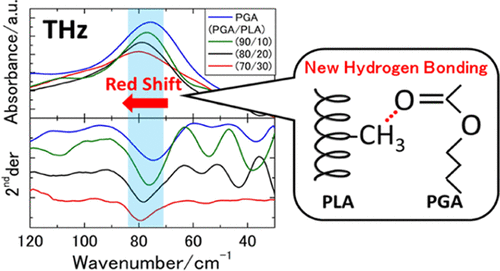当前位置:
X-MOL 学术
›
Macromolecules
›
论文详情
Our official English website, www.x-mol.net, welcomes your
feedback! (Note: you will need to create a separate account there.)
Study of Co-crystallization and Intermolecular Hydrogen Bondings of Poly(glycolide-co-l-lactide) Copolymers by Terahertz and Low-Frequency Raman Spectroscopy
Macromolecules ( IF 5.1 ) Pub Date : 2021-06-16 , DOI: 10.1021/acs.macromol.1c00561 Atsushi Nishimae 1 , Harumi Sato 1, 2
Macromolecules ( IF 5.1 ) Pub Date : 2021-06-16 , DOI: 10.1021/acs.macromol.1c00561 Atsushi Nishimae 1 , Harumi Sato 1, 2
Affiliation

|
The co-crystallization and intermolecular hydrogen bonding of poly(glycolide-co-l-lactide) [P(GA-co-LLA)] copolymers have been studied using differential scanning calorimetry (DSC), wide-angle X-ray diffraction (WAXD), small-angle X-ray scattering, and infrared (IR), terahertz, and low-frequency Raman spectroscopy. The DSC and WAXD results confirm that the melting point of the P(GA-co-LLA) copolymers decreases linearly and the spacing of the (110) and (020) planes expands as the concentration of polyglycolic acid (PGA) in the copolymers decreases. Furthermore, the lamellar thickness of the P(GA-co-LLA) copolymers increases with an increase in the concentration of polylactic acid (PLA), which is the same as that of poly(3-hydroxybutyrate-co-3-hydroxyvalerate), a co-crystallized copolymer. These results indicate that P(GA-co-LLA) copolymers are co-crystallized. The copolymers show a terahertz band at approximately 75 cm–1 and Raman bands at approximately 130 and 80 cm–1. The corresponding terahertz band at 75 cm–1 and Raman bands at 130 and 80 cm–1 of the PGA homopolymer show a shift to a relatively low frequency during the heating process because of thermal expansion. However, the terahertz band of the P(GA-co-LLA) copolymers at approximately 75 cm–1 shifts to a relatively high wavenumber, and their Raman bands at approximately 130 and 80 cm–1 do not show any shift despite the expansion of the crystal lattice of the P(GA-co-LLA) copolymers with the increasing concentration of PLA. The different behaviors of the shifts between the PGA homopolymer and P(GA-co-LLA) copolymers are due to the presence of PLA, and the co-crystallization can induce the formation of new intermolecular interactions between PGA and PLA. The temperature dependence of the IR bands of the P(GA-co-LLA) copolymers in the C═O, CH2, and C–O–C stretching regions suggests that the new intermolecular interaction of C═O···H3C is formed because of the co-crystallization of the P(GA-co-LLA) copolymers and the C–H···O(ether) hydrogen bonding in the PGA homopolymer is maintained in the P(GA-co-LLA) copolymers. Therefore, P(GA-co-LLA) copolymers that form co-crystallization have two types of hydrogen bondings: C═O···H3C and C–H···O(ether) hydrogen bondings.
中文翻译:

用太赫兹和低频拉曼光谱研究聚(乙交酯-co-l-丙交酯)共聚物的共结晶和分子间氢键
的共结晶和聚间氢键(glycolide-共-升-丙交酯)[P(GA- CO -LLA)]共聚物已经使用差示扫描量热法(DSC),广角X射线衍射研究(WAXD )、小角度 X 射线散射、红外 (IR)、太赫兹和低频拉曼光谱。DSC 和 WAXD 结果证实,随着共聚物中聚乙醇酸 (PGA) 浓度的降低,P( GA- co- LLA) 共聚物的熔点线性降低,(110) 和 (020) 面的间距扩大. 此外,P(GA- co-LLA)与增加的聚乳酸(PLA)的浓度,这是相同的聚(3-羟基丁酸酯的共聚物增加共-3-羟基戊酸酯),共结晶共聚物。这些结果表明,P(GA- CO -LLA)共聚物共结晶。共聚物在大约 75 cm –1处显示出太赫兹波段,在大约 130 和 80 cm –1处显示出拉曼波段。由于热膨胀,PGA 均聚物在 75 cm –1处的相应太赫兹波段和在 130 和 80 cm –1处的拉曼波段显示出在加热过程中向相对较低频率的转变。然而,P( GA- co- LLA) 共聚物的太赫兹波段在大约 75 cm–1转变为相对较高的波数,尽管 P( GA- co- LLA) 共聚物的晶格随着 PLA 浓度的增加而扩展,但它们在大约 130 和 80 cm –1处的拉曼谱带没有显示任何转变. 的PGA均聚物和P(GA-之间的偏移的不同的行为共-LLA)共聚物是由于PLA的存在,和共结晶可诱导的PGA和PLA之间的新的分子间相互作用的形成。P( GA- co- LLA) 共聚物在C=O 、CH 2和 C-O-C 拉伸区域的 IR 谱带的温度依赖性表明 C=O…H 3的新分子间相互作用C被因为P(GA-的共结晶的形成共保持在P(GA--LLA)共聚物和C-H ... O(乙醚)氢在PGA均聚物粘合共-LLA)共聚物。因此,P(GA- CO -LLA)共聚物其形式共结晶具有两种类型的氢键的:C = O ...ħ 3 C和C-H ... O(乙醚)氢键。
更新日期:2021-07-13
中文翻译:

用太赫兹和低频拉曼光谱研究聚(乙交酯-co-l-丙交酯)共聚物的共结晶和分子间氢键
的共结晶和聚间氢键(glycolide-共-升-丙交酯)[P(GA- CO -LLA)]共聚物已经使用差示扫描量热法(DSC),广角X射线衍射研究(WAXD )、小角度 X 射线散射、红外 (IR)、太赫兹和低频拉曼光谱。DSC 和 WAXD 结果证实,随着共聚物中聚乙醇酸 (PGA) 浓度的降低,P( GA- co- LLA) 共聚物的熔点线性降低,(110) 和 (020) 面的间距扩大. 此外,P(GA- co-LLA)与增加的聚乳酸(PLA)的浓度,这是相同的聚(3-羟基丁酸酯的共聚物增加共-3-羟基戊酸酯),共结晶共聚物。这些结果表明,P(GA- CO -LLA)共聚物共结晶。共聚物在大约 75 cm –1处显示出太赫兹波段,在大约 130 和 80 cm –1处显示出拉曼波段。由于热膨胀,PGA 均聚物在 75 cm –1处的相应太赫兹波段和在 130 和 80 cm –1处的拉曼波段显示出在加热过程中向相对较低频率的转变。然而,P( GA- co- LLA) 共聚物的太赫兹波段在大约 75 cm–1转变为相对较高的波数,尽管 P( GA- co- LLA) 共聚物的晶格随着 PLA 浓度的增加而扩展,但它们在大约 130 和 80 cm –1处的拉曼谱带没有显示任何转变. 的PGA均聚物和P(GA-之间的偏移的不同的行为共-LLA)共聚物是由于PLA的存在,和共结晶可诱导的PGA和PLA之间的新的分子间相互作用的形成。P( GA- co- LLA) 共聚物在C=O 、CH 2和 C-O-C 拉伸区域的 IR 谱带的温度依赖性表明 C=O…H 3的新分子间相互作用C被因为P(GA-的共结晶的形成共保持在P(GA--LLA)共聚物和C-H ... O(乙醚)氢在PGA均聚物粘合共-LLA)共聚物。因此,P(GA- CO -LLA)共聚物其形式共结晶具有两种类型的氢键的:C = O ...ħ 3 C和C-H ... O(乙醚)氢键。





















































 京公网安备 11010802027423号
京公网安备 11010802027423号